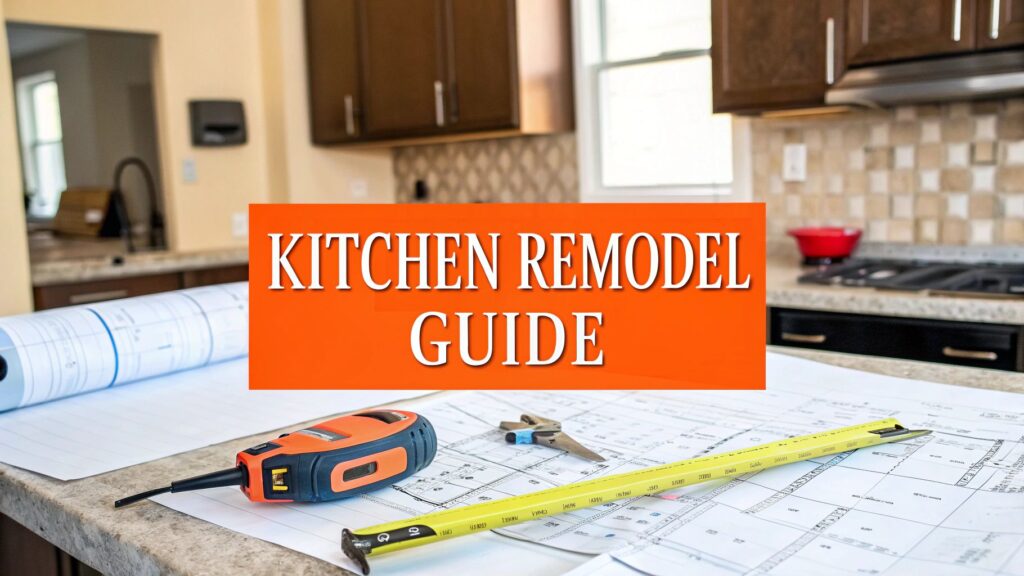Embarking on a kitchen transformation is a significant investment in your home and lifestyle. The project typically breaks down into a few core phases: the crucial initial planning and budgeting, the active construction phase, and finally, the installation and finishing touches. Having a clear roadmap from a trusted expert is what turns a potentially stressful project into a manageable and exciting journey. This guide to the steps in a kitchen remodel is designed to provide that clarity.
Demystifying the Kitchen Remodel Journey
Deciding to remodel your kitchen is a commitment to improving your home’s value and your daily life. For many homeowners in Orange County, it’s not just about achieving a new look; it’s about creating a functional, beautiful space that works for their family. The process can seem overwhelming, but with a licensed, certified partner like Sparkle Restoration Services, you can navigate each stage with confidence and ensure the final result is exactly what you envisioned.
Understanding the project’s flow is the first step toward a stress-free experience. This high-level overview helps you see the sequential phases of a successful kitchen remodel, from initial concepts to the final reveal.
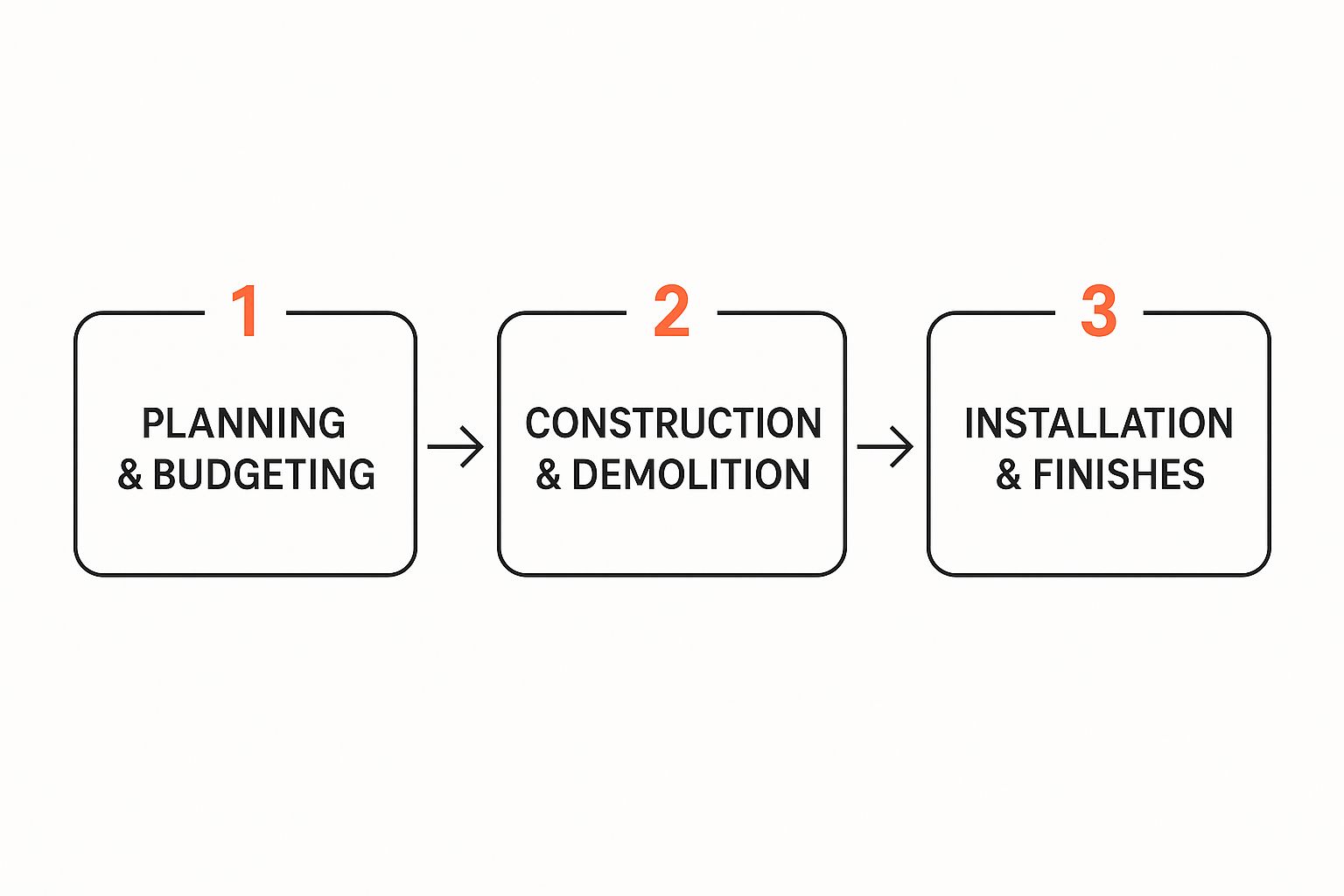
This visual roadmap simplifies the process, showing how a solid foundation in planning leads directly to a smoother construction phase and a beautifully executed finish.
Kitchen Remodel Phases at a Glance
Here is a high-level overview of the sequential phases in a successful kitchen remodel, helping you understand the project’s flow from start to finish.
| Phase | Key Objective | Typical Timeline |
|---|---|---|
| Phase 1: Planning & Design | Finalize layout, select materials, hire contractors, secure permits. | 1-4 Months |
| Phase 2: Demolition & Prep | Tear out old kitchen, address structural/utility changes. | 1-2 Weeks |
| Phase 3: Construction & Rough-In | Install new plumbing, electrical, framing, and drywall. | 2-4 Weeks |
| Phase 4: Installation | Cabinets, countertops, flooring, and major appliances go in. | 2-3 Weeks |
| Phase 5: Finishing Touches | Install backsplash, lighting, paint, hardware, and complete final details. | 1-3 Weeks |
| Phase 6: Final Inspection | Final walkthrough, punch list completion, and official sign-off. | 1 Week |
This table provides a bird’s-eye view, but remember that every project is unique. The key is to follow the sequence to avoid costly backtracking and delays.
Why Remodel Your Kitchen Now
Kitchen renovations consistently prove to be one of the wisest investments a homeowner can make. The numbers back it up: a recent survey showed that about 51% of homeowners planned to remodel their kitchens this year, driven by a desire for more functional space and updated style.
Even better, the return on investment (ROI) for even minor kitchen remodels is remarkably high. Homeowners often recoup about 96.1% of their expenses through the boost in their home’s value. You can explore the full kitchen remodeling trends to see exactly why this project is so popular right now.
As a BBB Torch Award Winner for Ethics, Sparkle Restoration Services believes in transparent and meticulous planning. A well-defined roadmap not only manages expectations but also protects your investment, turning potential chaos into a calm, controlled process.
This guide is designed to be that clear roadmap. By breaking down the essential steps in a kitchen remodel, we empower you with the knowledge to make informed decisions—whether you’re in Newport Beach, Irvine, or anywhere across Southern California. Our goal is to help you achieve a final space that isn’t just beautiful, but a true reflection of your lifestyle.
Building Your Strategic Design Foundation
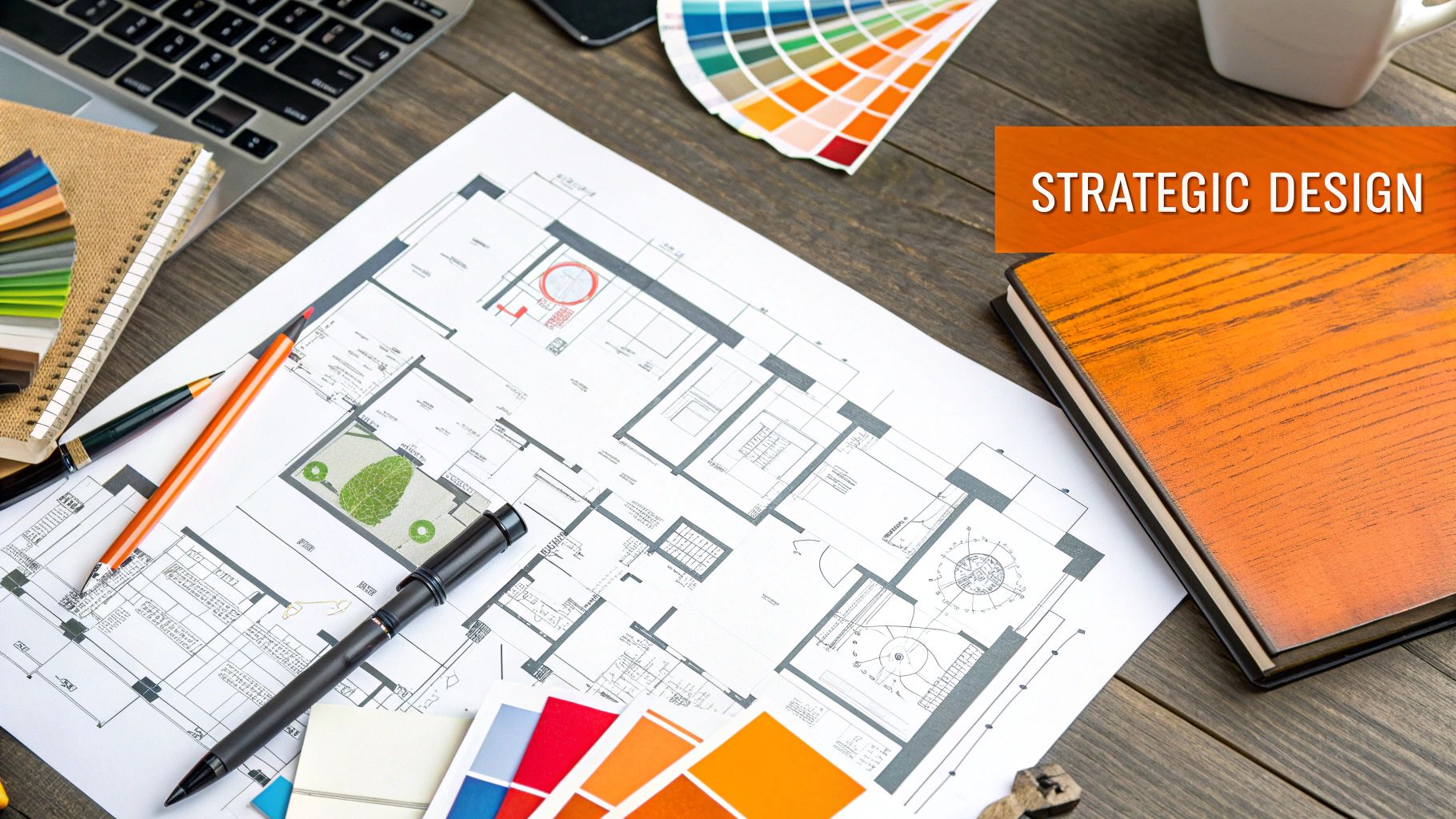
With your goals mapped out, it’s time to turn that vision into a workable plan. We cannot overstate this: the strategic design phase is the most critical part of any kitchen remodel. Every choice made now will ripple through the project’s timeline, budget, and the final look of your kitchen.
Rushing this stage is a common mistake that almost always leads to expensive changes and frustrating compromises down the road.
First, let’s talk about the layout. The flow of your kitchen has to work for you. Are you a serious home chef who dreams of a perfect work triangle, or is your Newport Beach home the go-to spot for entertaining, making an oversized island the star of the show? Before selecting materials, you must nail down the function. A great way to get started is to simplify layout planning with an interior design bubble diagram to organize your thoughts visually.
Getting this foundation right ensures the finished space feels intuitive and genuinely supports your lifestyle.
From Concept to Buildable Plans
Once you’ve settled on a layout, we can shift to aesthetics and materials. This is where you decide on a cohesive style—coastal modern, timeless traditional, or sleek and contemporary—and start picking the elements that will bring it to life.
But a great idea is only as good as its execution. This is where having an experienced team in your corner pays dividends. Our design-build services bring the design and construction worlds together from day one. This integration means your creative vision is always grounded in what’s practical and buildable, eliminating surprises.
We translate your ideas into detailed blueprints and 3D renderings, which lets you “walk through” your new kitchen before a single hammer swings. You can see exactly how the light will hit the countertops or how that cabinet color looks next to the backsplash. It’s a game-changer.
Visualizing your project with detailed 3D renderings is invaluable. It removes the guesswork and ensures everyone—from you to the project manager—is on the exact same page. It’s the single best way to prevent miscommunication and ensure the final result is precisely what you approved.
Solidifying Your Budget
A solid, realistic budget is the backbone of any successful remodel. It’s easy to get caught up in the beautiful finishes, but a smart budget covers every aspect of the project.
We break it down into a few key categories:
- Materials: Cabinets, countertops, appliances, flooring, backsplash, and lighting.
- Labor: The cost for skilled professionals like electricians, plumbers, and installers.
- Contingency Fund: This is non-negotiable. Set aside 10-20% of your total budget as a buffer for the unexpected, like discovering outdated plumbing once the walls are open.
High-quality kitchen renovations are in high demand. The global kitchen remodel market was valued at $11.07 billion last year and is expected to climb to $11.94 billion. This shows that homeowners see their kitchens as a major investment in both their lifestyle and their property’s value.
When you create a detailed financial plan with a transparent, award-winning firm like Sparkle Restoration, you move forward with total confidence, knowing your investment is protected and your project is set up for success.
Choosing Materials and Assembling Your Team
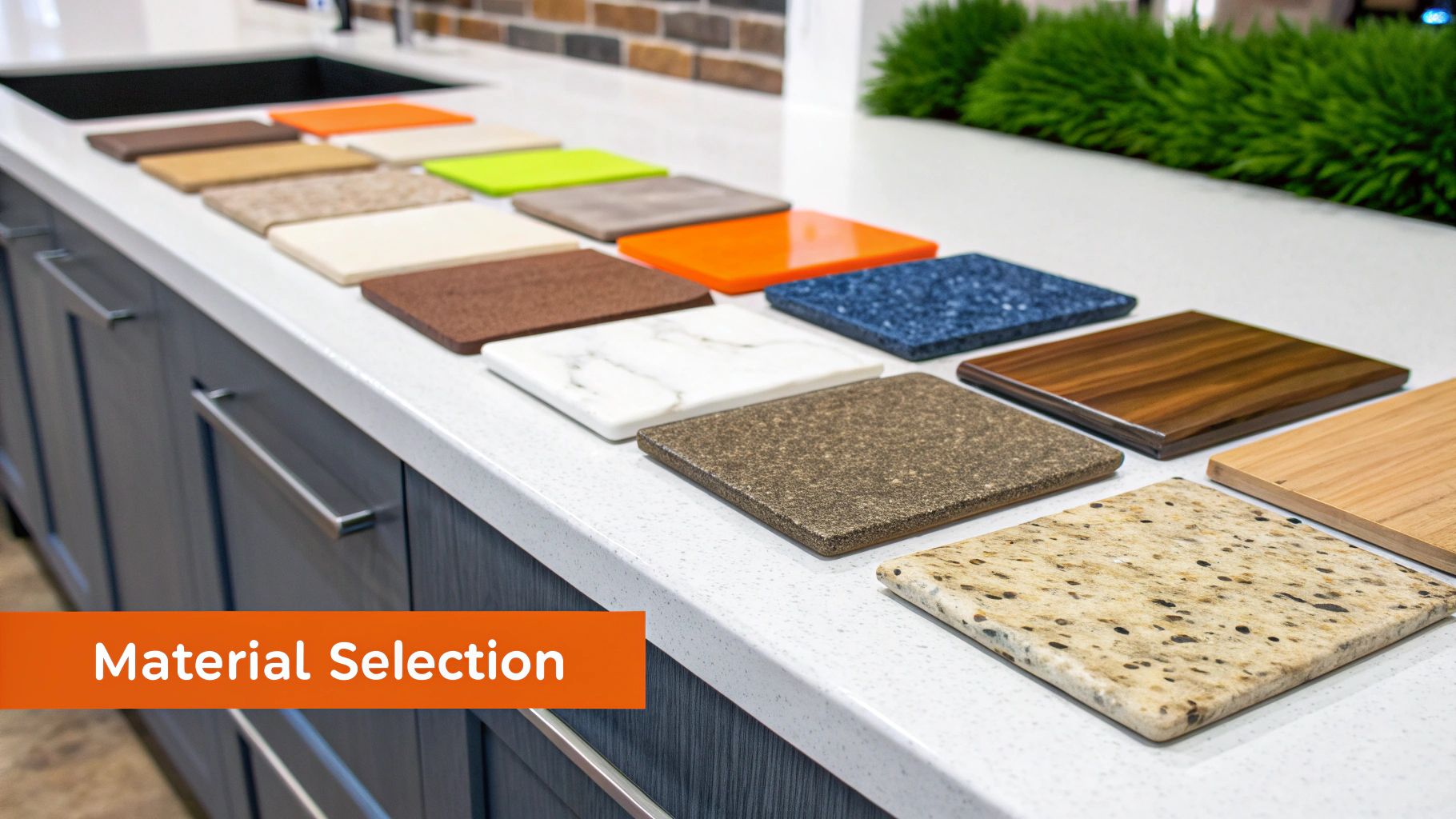
With a solid design blueprint in hand, it’s time to get tangible. This is one of the most exciting parts of any kitchen remodel: selecting the materials that will bring your vision to life. This is where your kitchen’s true personality begins to emerge.
Every choice, from the cabinet finish to the countertop edge, will impact the project’s aesthetics, durability, and budget. Making informed decisions now is critical. For example, the debate between custom, semi-custom, and stock cabinetry isn’t just about price; it’s about finding the perfect fit for your layout and storage needs. Likewise, choosing between a natural stone like granite and an engineered quartz involves weighing long-term maintenance against one-of-a-kind appearance.
Selecting Your Core Materials
Think of your materials as the foundational elements that everything else will be built upon. They form the functional and visual core of your new kitchen.
- Cabinetry: This is often the single largest investment in your kitchen. Semi-custom options usually hit the sweet spot, offering a great balance of design flexibility and cost. For older Orange County homes with unique layouts, fully custom cabinets can be a lifesaver, solving spatial challenges that off-the-shelf solutions can’t.
- Countertops: Quartz continues to be a favorite for good reason. Its incredible durability and low-maintenance nature make it perfect for busy families. Granite, on the other hand, offers unique natural beauty that can’t be replicated, but it does require periodic sealing to keep it looking its best.
- Flooring & Appliances: Your kitchen floor needs to be tough enough to handle heavy foot traffic and spills. Luxury vinyl plank (LVP) is a champion of durability and water resistance, while classic hardwoods add timeless warmth. It’s also wise to select your appliances early on, as their exact dimensions are crucial for finalizing the cabinet plans. As you explore these options, digging into additional material selection insights can offer fresh perspectives.
A common oversight we help clients avoid is underestimating lead times. Custom cabinets can take 8-12 weeks to arrive, and special-order appliances can face similar delays. Ordering these big-ticket items early is non-negotiable if you want to keep your project on schedule.
Securing Your Licensed General Contractor
Finalizing your material choices and locking in your professional team should happen in tandem. As your material selections sharpen the project’s scope, you’ll have the detailed information needed to secure a contract with a trusted general contractor. This is, without a doubt, the single most important decision you’ll make to protect your investment.
A detailed contract is your project’s legal backbone. It must explicitly outline the complete scope of work, a payment schedule tied to specific project milestones, and a clear timeline. Never sign a contract that feels vague or incomplete.
Most importantly, you must verify your contractor’s credentials. Ensure they hold a valid California General Contractor license and carry sufficient liability and workers’ compensation insurance. For a firm like Sparkle Restoration Services, this also includes advanced credentials like IICRC Master Certifications, which demonstrate a higher level of technical expertise in creating a safe, healthy home environment. While our guide on hiring a contractor for bathroom remodeling is for a different room, the core principles of vetting and due diligence are universal and invaluable.
Hiring an unqualified or uninsured contractor is one of the costliest mistakes a homeowner can make, leading to shoddy workmanship, dangerous code violations, and financial disputes. By partnering with a reputable, award-winning firm known for ethics and excellence—like a BBB Torch Award Winner—you ensure your project is managed with professionalism from day one. This diligence is what transforms potential remodeling chaos into a calm, successful outcome.
Navigating the Construction and Demolition Phase
Once your plans are locked in and materials are on their way, you’ve arrived at one of the most significant steps in a kitchen remodel: the physical transformation. This is where things get real—and often loud. With a professional team at the helm, this stage is less about chaos and more about exciting progress as your old kitchen makes way for the new.
To keep your daily life from being completely upended, proper preparation is everything. Before the first sledgehammer swings, the top priority is protecting the rest of your home.
Prepping Your Home for Construction
Containment is the name of the game. Our crews use plastic sheeting and dust barriers to completely seal off the kitchen from your other living spaces. This simple step is critical for protecting your furniture, valuables, and indoor air quality. We also map out clear, protected pathways for workers to bring materials in and haul debris out, keeping your home as clean as possible.
Another lifesaver during this phase is setting up a temporary kitchen. It doesn’t have to be fancy—a corner of the dining room or garage will do. Typically, this includes:
- Your refrigerator, moved to its temporary home.
- A microwave and a coffee maker for handling simple meals and morning routines.
- A small, designated area for essential dishes, utensils, and pantry staples.
This makeshift kitchen makes a world of difference. It lets your family maintain a semblance of normalcy while the main event is underway, drastically improving your comfort level throughout the project.
The Demolition and Rough-In Sequence
Demolition is far more than brute force; it’s a careful, strategic deconstruction. Our licensed general contractors work methodically, shutting off all water and electrical supplies before a single cabinet or countertop is touched.
This is also the moment surprises may appear, like old, corroded plumbing or unexpected structural beams. It happens more often than you’d think, which is exactly why that contingency fund is non-negotiable.
In older Orange County homes, we are particularly mindful of hazardous materials. Before attempting any DIY demolition, it’s crucial to understand the risks. Disturbing materials like asbestos can have severe health consequences. For more on this, check out our guide on the link between asbestos and DIY home improvements.
A professional project manager from a firm like Sparkle—which holds both a General Contractor license and IICRC Master Certifications—doesn’t just supervise demolition. They manage risk. We ensure the entire process is safe, compliant, and handled with the utmost care for your family’s well-being.
Once the space is stripped down to the studs, the “rough-in” work begins. This is where the new skeleton of your kitchen starts taking shape. Plumbers and electricians run new lines for the sink, dishwasher, and all planned lighting. Any framing for new walls or structural changes happens now, too. It’s a highly coordinated effort to ensure every pipe and wire is placed perfectly according to the design.
This phase wraps up with one of the most important milestones: inspections. City officials verify that all new electrical, plumbing, and structural work is completely up to code. Passing these inspections is mandatory before we can move on to the installation phase, where your vision finally becomes a tangible reality.
Executing the Installation and Finishing Touches
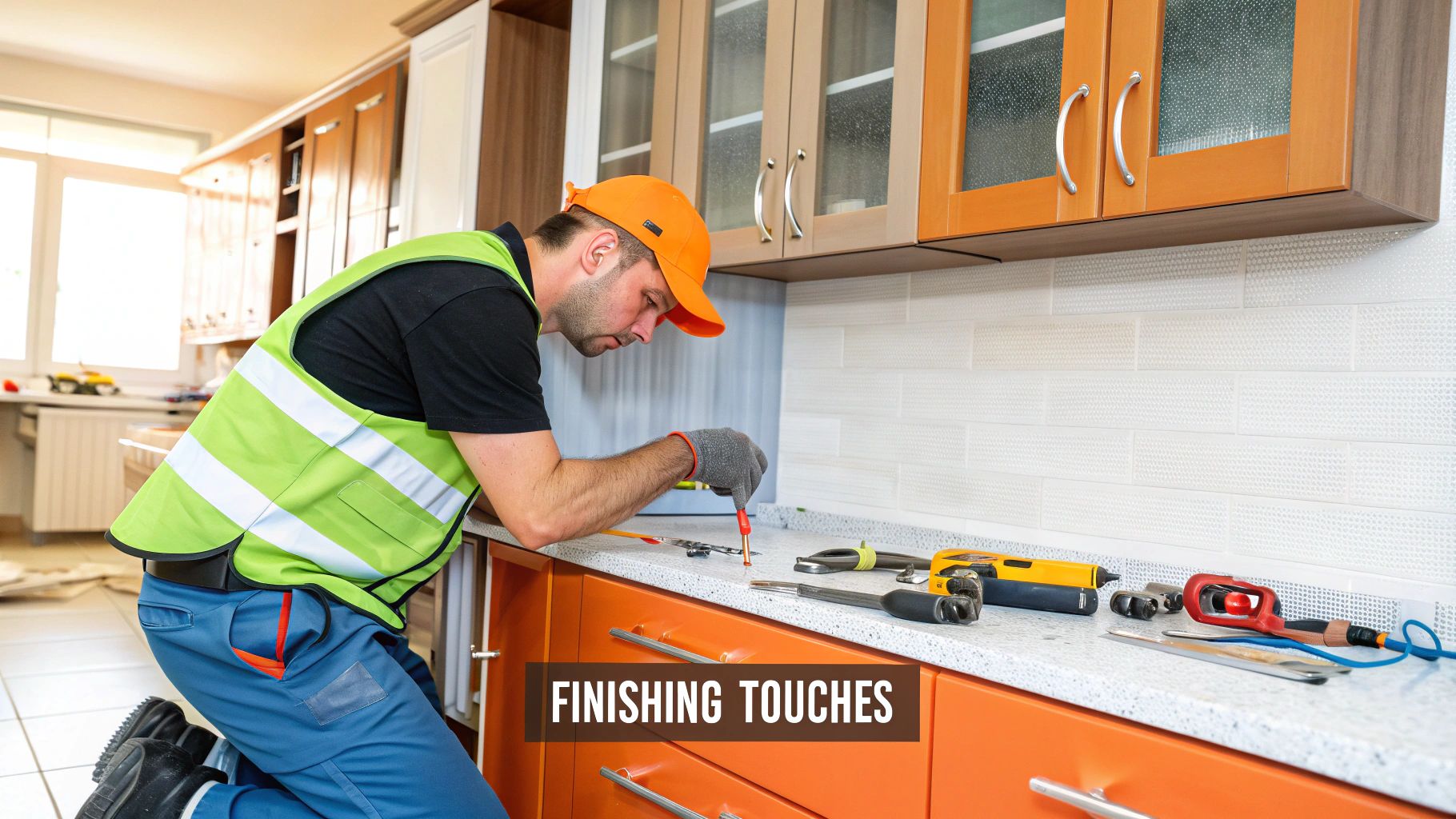
After the demolition and heavy construction, this is the moment things really start to come together. The dust settles, and your vision finally begins to take shape. This is easily one of the most rewarding steps in a kitchen remodel because you see all those carefully chosen elements installed, turning what was a construction zone into the heart of your home.
The precision needed here is immense; this is where true craftsmanship really shows.
It all starts with the foundational pieces. The cabinets are meticulously set, leveled, and secured, forming the kitchen’s skeleton. Next are the countertops, a job that requires expert templating and fitting to ensure every seam is invisible and the finish is flawless. Once these large elements are in, the kitchen’s personality really starts to shine.
Installing Flooring and Major Fixtures
With the cabinets and countertops beautifully in place, our attention turns to the floor. Proper flooring installation is critical and requires a perfectly clean, level subfloor to guarantee a flawless look that lasts for years. Your choice of material—whether it’s elegant hardwood, durable luxury vinyl, or classic tile—will determine the exact installation method.
For homeowners here in Orange County weighing their options, getting professional advice on flooring sales and installation services can make all the difference in finding the perfect balance between style and durability.
Next, the workhorse appliances that make a kitchen functional are carefully brought in. The refrigerator, oven, range, and dishwasher are all moved into their designated spaces. This is followed by the crucial work of connecting all the plumbing and electrical. A licensed plumber will expertly install your sink and faucet, while a certified electrician hooks up the appliances and lighting, ensuring everything works perfectly and meets all local safety codes.
The order of operations here is intentional. We install flooring after the base cabinets are in. Why? It protects your beautiful new floor from damage during cabinet installation and saves you money on materials, since there’s no need to lay expensive flooring under cabinets where no one will ever see it. This is the kind of practical, professional insight that keeps a project on schedule and within budget.
Applying the Polished Finishing Touches
The final details are what take a kitchen from simply functional to truly stunning. The backsplash goes in, adding that perfect pop of color, texture, and personality while also protecting your walls from spills and splatters.
Then comes a fresh coat of paint, which ties the whole room together. Finally, the “jewelry” of the kitchen is added: cabinet hardware, outlet covers, and the final light fixtures are all installed.
More homeowners are seeing the value in having this level of detail managed by professionals. Spending on kitchen remodeling is projected to jump by 2.6%, and homeowners are overwhelmingly choosing pros over DIY. An average investment of around $27,000 for a major kitchen remodel can see a return of about 50% in added home value, highlighting why expert execution is so important.
Before we call the job complete, we conduct a final walkthrough with you. This is our chance to create a “punch list”—a detailed list of any small adjustments or touch-ups needed. As a BBB Torch Award Winner for Ethics, Sparkle Restoration Services is committed to ensuring every detail is perfect, delivering a finished kitchen that doesn’t just meet your expectations, but exceeds them.
Your Kitchen Remodel Questions Answered
Remodeling your kitchen is a significant undertaking, and it’s normal to have questions. As Orange County’s trusted, client-focused remodeling experts, we’ve heard them all. We believe in providing clear, direct answers so you can move forward with confidence.
Here are a few of the most common questions we get from homeowners.
How Long Does a Typical Kitchen Remodel Take?
The honest answer is: it depends entirely on the scope. A simple cosmetic refresh—new countertops, backsplash, and paint—might wrap up in 4-6 weeks.
However, a full-gut renovation in an older Newport Beach home will have a longer timeline. Projects involving moving walls, re-routing plumbing, and installing fully custom cabinetry can easily take 3 to 5 months from the first design meeting to the final walkthrough.
Several key factors will influence your project’s schedule:
- City Permitting: Securing the necessary approvals from the city can add several weeks before work begins.
- Material Lead Times: This is a major factor. Custom cabinets or special-order European appliances can have lead times of 8-12 weeks or more.
- The Scope of Work: Any structural changes will add significant time to the project.
Meticulous planning with an experienced general contractor is the best way to establish a realistic schedule and avoid frustrating delays.
What Is the Most Expensive Part of a Kitchen Remodel?
Without a doubt, cabinetry is almost always the single biggest line item on the budget. It often accounts for 30-40% of the total cost. The final price is driven by your choice of materials, construction quality (custom vs. stock), and finishing details.
After cabinets, your next major expenses are typically labor and appliances. In fact, a high-end, professional-grade appliance package can sometimes cost as much as the cabinets themselves. This is why locking in these major decisions early in the design phase is critical for keeping your budget on track.
Can I Live in My House During the Remodel?
Yes, you absolutely can stay in your home, but it requires preparation. The construction phase is disruptive—it will be noisy and dusty, and you’ll be without a functional kitchen for a while.
To make it manageable, we always help homeowners set up a temporary kitchen somewhere else, like the dining room or garage. This usually means moving your refrigerator and setting up essentials like a microwave, a coffee maker, and a small counter space. For a deeper look at common concerns, feel free to check out our full list of frequently asked questions.
As a company committed to “Turning Chaos Into Calm, Fast,” we make containment a top priority. We use plastic barriers and air scrubbers to control dust and establish clear, safe pathways for our crew. It’s all about minimizing the impact on your daily life and making the process as stress-free as possible for you and your family.
Ready to take the first exciting step toward the kitchen you’ve always wanted? The expert design-build team at Sparkle Restoration Services is here to guide you through every single phase. We bring the same professionalism and ethical excellence that earned us the BBB Torch Award to every project.
Schedule your complimentary consultation today and let’s start creating a space that truly fits your life.
Schedule Your Free Orange County Kitchen Remodel Consultation

